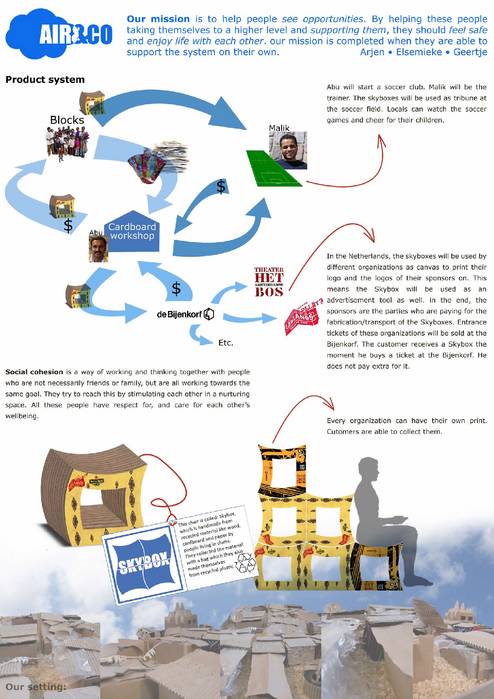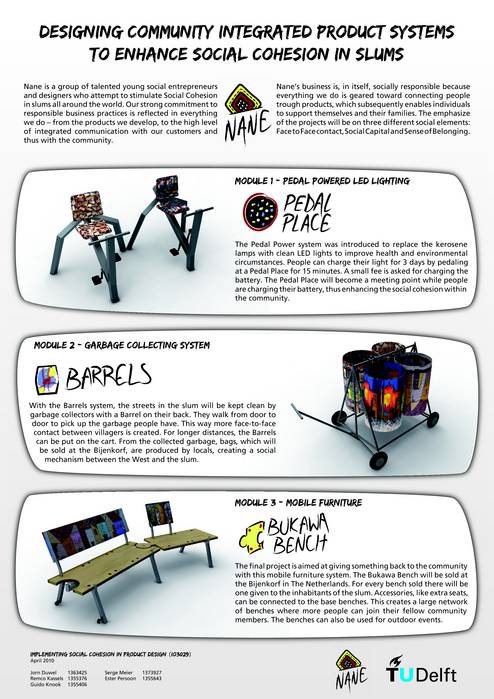3 I’s METHODOLOGY
3-I Methodology ‘ Step by Step’

Students start a SC Design project selecting a sample of the community for which they execute an assignment. This sample of the community is called: Setting X. Elements, actors (users as well as non -users), and events are identified.
The Setting X is modeled into a 3D Scenario board. The 3D Scenario Board is the focal point all along the project. Building this maquete students prepare themselves mentally and develop empathy for the community to design for. They include elements of the Setting X in subscenarios for a Community Integrated Product System (CIPS), assemble a main scenario and finally elaborate on the ” Look & Feel” of the concept to communicate their specific Social Cohesion design mission of the project. Q methodology (see lectures/workshops) may be applied in case of a concrete setting wihere actors may be interviewed (Douwe Egberts Coffee-Case 2010-2011).In case of an abstract assignment (BoP Slum-Case 2009-2010) a mission is formulated based on opportunities as perceived by the students.
The 3-I methodology comprises 3 stages : i-1, i-2, and i-3.
Each stage consists of 3 steps.
i-1 /The Identification stage:
- Step 1: Selecting Setting X, actors, elements and events;
- Step 2: Developing the Social Cohesion Design mission, adding Q methodology in case of a concrete setting.
- Step 3: Generating Subscenarios on an individual basis.
i-2/The Integration stage:
- Step 4: Selecting and modifying Subscenarios as a team, applying the Subscenario matrix.
- Step 5: Applying Harris Profile methodology and/ or Q methodology to co value most promising Subscenarios.
- Step 6: Constructing main Scenario from Subscenarios. Presenting the SC Design concept to the client.
i-3/The Implantation stage:
- Step 7: Elaborating the “Look & Feel” of the concept.
- Step 8:Proposing strategic partners to the client for project realisation.
- Step 9:Communicating the Social Cohesion design mission of the final concept by developing a promo/ presentation plan for a fictive tradeshow
I-1: Identification
Description
Selecting a Setting X, developing the Social Cohesion Design Mission and generating Subscenarios.
Step 1
- Organise SC-Design Team
- Analyse Assignment
- Choose setting X, Identify Actors, Elements & Events
- Build 3D Scenario Board of Setting X
Setting X is a sample taken from the community in which the technology is to be implemented.
Setting X consists of elements (In the Coffee Case assignment 2010-2011: copymachine, toilets, staircase, offices, service desk, video screens, speakers, etc. present at the setting X). Actors consist of employers, employees, cleaning personal, etc. For setting X ‘Fields of Opportunity’ are identified: Potential events that may take place when certain elements in the Setting X are included in the technology design. Elements and their ‘Fields of Opportunity’ are distributed among the team members to start writing Sub Scenarios.
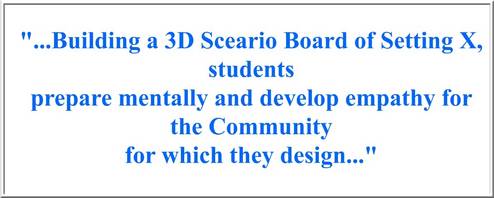





Step 2
Conduct research into SC-perception.
Apply Q Methodology and Factor Analysis. Define SC mission.
see… lectures/workshops
Do-It-Yourself SC Design Toolkit.
For the Douwe Egberts case 2010-2011 studentteams were equiped with: the Do-It-Yourself SC Design Toolkit.
The Toolkit contained :
- The SC Design instruction manual;
- The SC Design Q Board, and the full set of Q cards;
The Toolkit functioned as a storage space for the 3D Scenario Board.




Step 3
Develop Sub Scenarios on Individual basis.
Taking into account that scenarios for tech implant are focusing users as well as non-users! In SC Design students design for actors (users and non users, influenced by the technology). Drama is used as the Course ” Methaphor”. Approximately 7 Subscenarios per team member are developed.

Deliverables i-1
Deliverables:
- 3D Scenario Board
- SC Design Mission
- Draft Report I-1
- PPT Presentation 7 Minute Pitch





I-2: Integration
Description
Constructing a Community Integrated Product System (CIPS) from Subscenarios.

Step 4
Select & Modify most promising Sub Scenarios as a Team employing SC Design Subscenario Matrix technique.




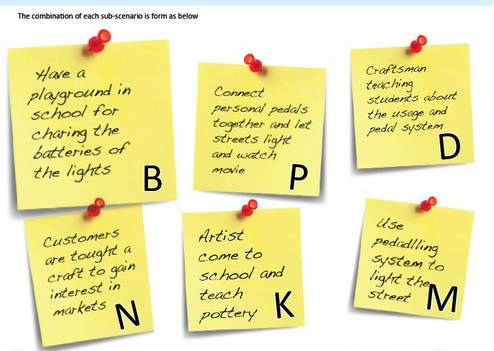
Step 5
Co-Value Sub Scenarios with Actors and Client. Apply Harris Profile Methodology.
In case of a concrete context (Coffee case 2010-2011) Q methdology may be applied to measure perception of most promising subscenarios by actors.

To improve the visuality of the Harris Profile, the SC Design Harris Profile represents criteria weight factors graphically as well in the diagram. See under.

Step 6
Construct Community Integrated Product System (CIPS), based on most promising Sub scenarios.
Deliverables i-2
- Concept for CIPS in 3D CAD drawings.
- Draft Report i-2.
- PPT Presentation / 7 Minute Pitch
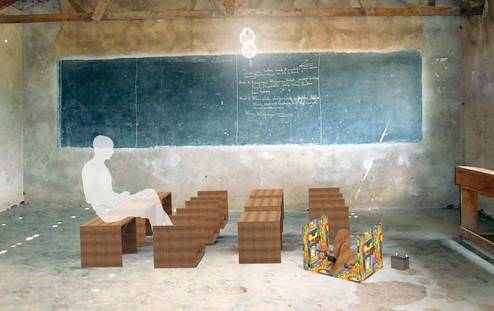



I-3: Implantation
Description
Developing the “Look & Feel” of the CIPS and developing a strategic plan for introduction of the CIPS in the community.
Step 7
Develop Business, Branding & Promotion Plan (BBP).
Step 8
Evaluate Final Concept with Actors. Apply Likert Scale Methodology for perception of SC-improvement.


Step 9
Deliverables
- Final CIPS Concept in 3D CAD.
- Final SC Design Report.
- PPT presentation 7 Minute Pitch.
- A0 Poster.
- Evaluation enquete.


